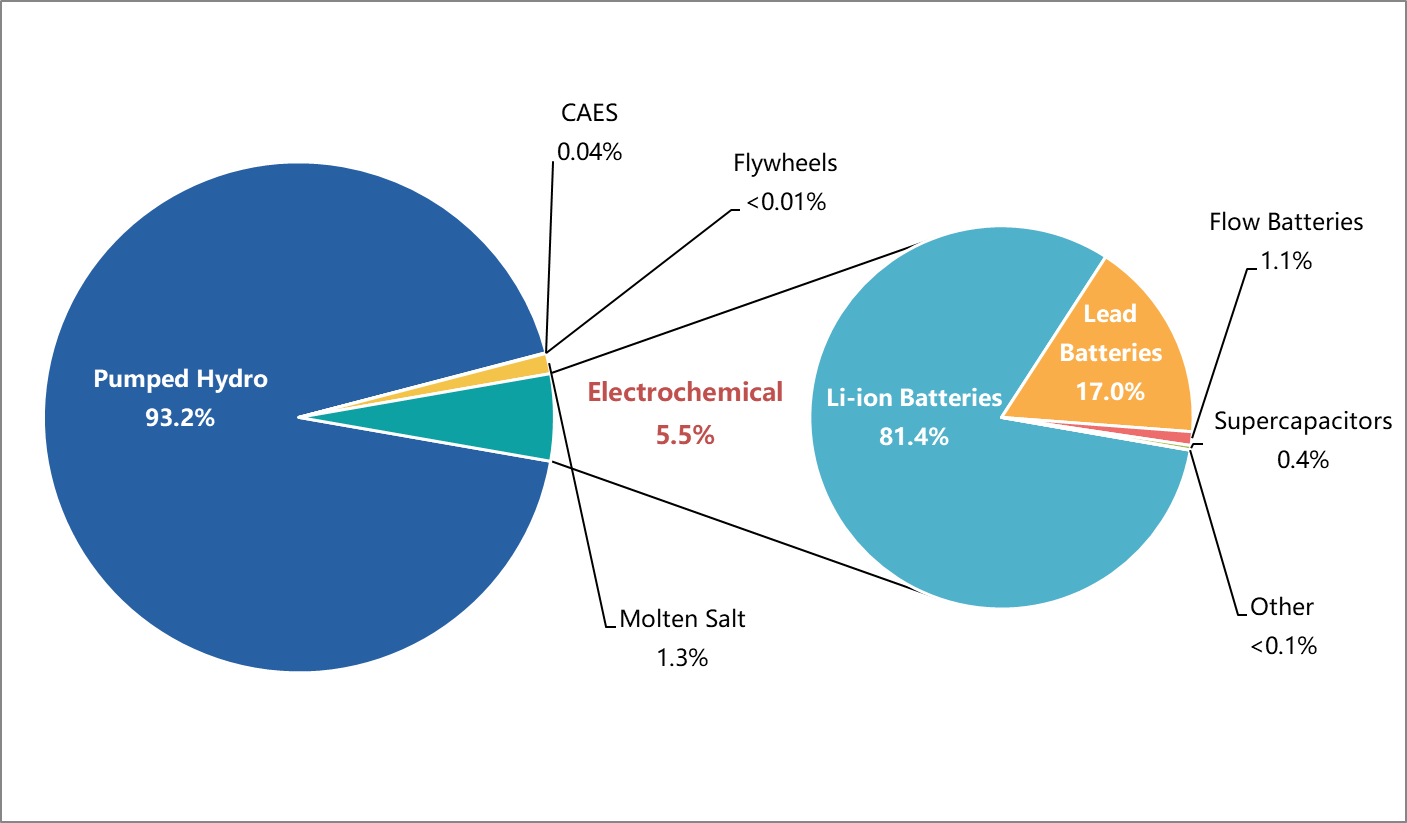As power market reforms continue to develop, the ancillary services market has become a major area of focus. Energy storage serves as one strategy for ancillary services, capable of providing fast, precise response and flexible deployment. Energy storage has already achieved commercial breakthroughs in ancillary services applications. Yet in many facets, a market mechanism and policy environment that supports the efficient and rational application of energy storage is still lacking. As the amount of renewable generation in China increases, the power system requires greater integration of flexible resources for regulation. In the low-carbon energy system of the future, energy storage will play a critical role in renewable integration and grid stability. Compared to many other regions, China’s ancillary services market is still in the infant stages of construction. Reasonable market regulations require further exploration, and actions must be taken to ensure existing regulations are updated, thereby ensuring that the energy system moves in the direction which supports long-term development.
Marketization Progresses, Yet Many Problems Persist
Current problems and challenges to the participation of energy storage in the ancillary services market can be summarized as follows:
1. Defining energy storage’s identity in the ancillary services market
Defining energy storage’s “identity,” in other word, determining how energy storage should enter the market, is an issue with challenges at two levels:
The first challenge is that while regulatory structures may allow energy storage to enter the market, in actual practice implementation may face difficulties. Regulations across many regions have already defined energy storage’s place in ancillary services markets, allowing energy storage to participate as both independent stations or when paired directly with thermal generation. Yet in actual practice, aside from energy storage systems which are tied directly to thermal generators, many energy storage systems are unable to enter the market because current transaction and dispatch methods are unable to support such systems’ provision of services. Other problems exist in land approval, grid connection, and other permissions. Looking forward, independent energy storage stations and aggregated behind-the-meter energy storage stations will be a driving force for the participation of energy storage in ancillary services markets, though additional technical support and policy developments are needed to make such models a reality.
The second challenge is of the “treatment” of energy storage in comparison to other participating entities, or the problem of “fairness.” Currently, there are many regions where redundant generators squeeze the market space from high-quality resources. Ancillary services dispatch strategies are also simple, and there is no optimized scheduling mechanism for independent energy storage stations. These dispatch strategies will also be unable to meet future power spot market demands. It is for these reasons that energy storage projects have tended to be bound with independent dispatching entities, as it is still difficult for independent storage stations to truly and fairly compete with other market entities.
2. Energy storage investment returns are still difficult to guarantee
Though energy storage takes part in the ancillary services market, profits have still been difficult to guarantee. When the market first opened, energy storage could obtain high value returns primarily in areas where ancillary services would receive compensation according to effectiveness. However, rapidly changing policies have had a major influence on the investment returns for energy storage that participates in the ancillary services market. In 2019, the North China Energy Regulatory Bureau modified the upper limit of the K value for the “two regulations”* in northern China, and amended the western Inner Mongolia calculation methods for both daily grid regulation and the daily contribution of electricity provided by AGC frequency regulation. These measures caused a noticeable decline in revenue for frequency regulation services.
3. A long-term operations mechanism for an ancillary services market is still lacking
Generally speaking, China’s ancillary services market mechanism has yet to fully form. The costs and compensation for energy storage and other new grid regulation resources that provide frequency regulation do not completely reflect the needs of the power system, and the market has not transmitted the initial costs for such resources to the actual beneficiaries. This issue is part of a larger problem with ancillary services. Ancillary services are closely related to the construction of power markets, particularly spot markets. There is an urgent need to improve the ancillary services price mechanism through further power market reforms, and gradually link ancillary services market regulations with spot markets. These actions are necessary for new technologies and new market entities to freely participate in the market and obtain reasonable value returns.
How Regulations for Energy Storage Participation in Ancillary Services Markets are Designed in Foreign Countries
The United States was the first country to incorporate energy storage into its ancillary services network at a large scale. Numerous commercialized energy storage projects currently provide ancillary services to the US power grid. Energy storage has been able to successfully integrate into the US ancillary services system not only due to declining costs of storage, but also, and more importantly, due to actions by the Federal Energy Regulatory Commission (FERC) to define energy storage’s role within the ancillary services market. These actions include clarifying what kind of compensation energy storage should receive for its services, where ancillary services fees should come from, and other measures which have provide a legal and policy basis for supporting storage. Below, we examine some of the successful US experiences with energy storage.
1. Defining energy storage’s identity within the ancillary services market
In the US electricity wholesale market, energy storage is viewed as a special type of power resource, defined as a non-generator resource (NGR). Unlike generators, an NGR can be flexibly dispatched to any level within their operating capacity range. NGRs have two major characteristics: first, NGR models are usually simpler than that of conventional generators; there is no cost for startup or shutdown, minimum load cost, or transition cost. Second, NGRs can provide energy services, capacity services, and a variety of ancillary services. There are only two price quotations for energy storage in the wholesale market, a charge quotation and a discharge quotation. To guarantee participation in the market, operations costs are kept low to guarantee a winning bid, and energy storage infrastructure is typically quoted at zero.
2. Defining of the “pay-for-performance” mechanism
Based on the principle that energy storage is a resource able to provide high-quality electricity, it is provided status equal to that of conventional energy storage as a provider of ancillary services. The compensation mechanism used for ancillary services provided by conventional energy sources is also suitable for energy storage. Therefore, no matter the type of energy storage technology, it will receive reasonable compensation based on grid regulation ability.
On Dec 12, 2011 FERC released order no. 755, Frequency Regulation Compensation in the Organized Wholesale Power Markets. The order requires power markets to release compensation plans which pay according to performance. Frequency regulation resources are compensated according to their actual level of contribution. The order requires frequency regulation ancillary services markets to provide two forms of compensation for frequency regulation resources: 1) a capacity payment which includes the opportunity costs of marginal resources, and 2) a performance-based payment which reflects the quality of the frequency regulation service being provided (for example, according to the accuracy of response to the dispatch signal) and the amount contributed. In general, the greater the mileage of frequency regulation, the higher the frequency regulation performance index, and the greater the compensation will be. Under the new compensation plan, capacity payments are no longer a “fixed” amount. When the frequency regulation performance index is at zero, it is possible that the capacity payment may also be zero. Therefore, the service provider’s frequency regulation performance will influence the final amount of compensation it receives for frequency regulation services. These measures ensure that energy storage systems providing AGC frequency regulation receive suitable compensation for the services they provide.
3. Optimizing the clearing process
The PJM market is an example of a mature power spot market that has successfully operated for many years. In the PJM market, ancillary services and the spot market are jointly optimized and cleared, ensuring that accuracy is maintained for price changes due to frequency regulation provision and the opportunity cost losses of providing backup services. In order to fully marketize ancillary services, the specific timing of the PJM market joint optimization and clearing is as follows:
In the day-ahead market, the ISO will jointly optimize clearing of energy, frequency regulation, and reserves, but does not settle the frequency regulation. In the hour-ahead market, the ISO will reoptimize clearing, and determines the generator group and capacity of the winning frequency regulation resource. Before entering the hour of operation, the generators must adjust their output level according to the frequency regulation order, in other words, complete its bid commitment. After entering the hour of operation, the ISO will engage in joint optimized clearing of energy, backup, and frequency regulation. Each dispatch hour is divided into 12 scheduling periods, and each scheduling period lasts five minutes. Energy clearing is carried out every five minutes for market settlement. Once the location marginal price (LMP), frequency regulation capacity price, and frequency regulation mileage price for each dispatch period are determined, the arithmetic mean of the 12 scheduling periods is calculated, and the energy, frequency regulation, and reserve price for the dispatch period is calculated, resulting in the final frequency regulation market price.
This type of long-term mechanism for ancillary services, that is, one in which the costs of ancillary services is shared by power customers, has been implemented in most mature power markets abroad.
Suggestions for Regulations Addressing the Participation of Energy Storage in the Chinese Ancillary Services Market
Ancillary services markets in the US and other international markets are based on mature power spot markets, and designed according to electricity pricing signals with different timing and location characteristics.
In China, power spot market trials have only just begun to take off. The completion of a modern power market system will still require a large amount of time and effort. For the short and medium-term future, the power spot markets will remain in the trial period. In these trial regions, ancillary services compensation mechanisms must be paired with the construction of power spot market transaction mechanisms in order for gradual marketization to occur. For energy storage, installations which have regulatory capabilities and can receive orders from dispatch can be viewed as ancillary services providers, and may have grid-dispatching regulations designed according to their performance. At the same time, a quantitative evaluation must be conducted for energy storage’s frequency regulation performance as a substitute for conventional generators, thereby optimizing frequency regulation capacity and allowing more high-quality resources to enter the market. At the operational level, optimized joint clearing of frequency regulation, reserve, and energy would help increase the level of market efficiency. In terms of price sharing, it is ideal for the customer side to bear the costs of ancillary services, and for customers to participate in spot market transactions on a single track (that is, without priority power purchase customers).
In those regions in which spot market trials have not yet been initiated, the “planned dispatch+direct transaction” model will continue to exist for a long period. In these regions, the ancillary services abilities of generators with the least efficient adjustment capacity can be used as the starting point for compensated ancillary services, reflecting the fairness with which ancillary services are provided. At the same time, the inclusion of reserve capacity ancillary services products allows generators providing reserve capacity to receive reasonable benefits. In regard to price sharing, following the release of the plan, customers participating in direct transactions should bear the cost of ancillary services according to their own usage, and gradually transition to a model in which all ancillary services are borne by users.
Payment for ancillary services by power customers is an inevitable step in the transition of the existing ancillary services market from a “zero-sum game” between generators to true marketization. As the cost of sending electricity to the grid gradually liberalizes, the theoretical basis for the generation-side to cover ancillary services costs (in other words, including the cost of ancillary services in the benchmark electricity price) no longer exists. In a true transaction, both sides engage in a “game” over electricity prices, and ancillary services are not discussed. Considering that ancillary services are an important part of energy production, when it comes to marketization, no matter what the cost of ancillary services, they must be paid for by the power customers. In addition, as renewables continue to penetrate the grid at increasingly high capacity, one way to view the principle of “the beneficiary pays” is that since consumers use a higher proportion of renewable energy, they therefore enjoy the environmental benefits brought by green energy, and should in turn pay the cost for these benefits. The fees should not only cover the cost of the renewable energy, but also include the costs of ancillary services required to support renewable energy.
There are still many difficult questions, such as how costs may be passed on to consumers if pay-for-performance may cause ancillary services fees to rise, as well as the influence of the government’s efforts to lower the cost of electricity consumption in the real economy. These questions are ones that regulators currently tackle with, and one of the major reasons that the development of an ancillary services mechanism has been so difficult. In regard to these questions, we offer a few thoughts:
1. China’s overall ancillary services costs are relatively low compared to that of other countries with marketized energy systems, especially compared to countries with high levels of renewable energy, such as Germany and some northern European countries.
2. Due to many years of rapid construction of the power generation sector combined with recent economic slowdown, China is currently experiencing a stage of excess power availability. As power transactions become increasingly marketized, many regions are seeing direct transaction price averages which are lower than that of state-approved electricity prices, with some customers already enjoying preferential prices. Under these condition, transferring the cost of ancillary services to power customers will allow customers to see the costs of ancillary services on their power bills, yet experience an overall lowering of their electricity costs.
3. With the increased penetration of renewables in the grid, the need for ancillary services has also increased. As a high-quality regulatory resource, energy storage’s participation in the ancillary services market will help inhibit the rise of ancillary services costs.
The allocation of ancillary services costs to customers is the inevitable trend of the market. The pace at which this trend develops may be adjusted according to the pace of construction of the electric power spot market, but should not be implemented too late in the process. If we wait until the proportion of renewable energy in the power system is high enough to be noticeable to users, then resistance will be even greater than it is now.
In summary, when it comes to energy storage in the ancillary services market, a market mechanism should be optimized in stages. The market identity of various energy storage applications must be defined first, regulatory requirements in different power system environments should be clarified, and, finally, market regulation should be implemented which reflect the flexible regulation capabilities of energy storage, with beneficiaries paying for the cost of services.
*The “two regulations” are the Regulations for Operations and Management of Grid-Connected Power Stations in Northwest Regions and Regulations for Ancillary Services Management of Grid-Connected Power Stations















































